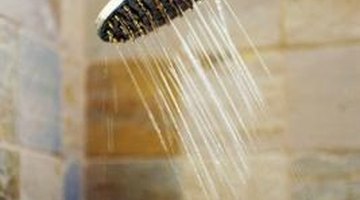Causes of Greasy Slime in Shower Stalls and How to Clean It
A greasy, slimy buildup on a shower wall has several causes, ranging from soaps and shampoos to cleaners and the water itself. Many kinds of soap or shampoo contain glycerin and animal fats that land on shower walls and leave a slimy residue. Some types of mold growing on the wall feel greasy to the touch, but are usually black in color. Water treatment facilities may add chemicals that leave the water feeling slimy. Remove the slime buildup from your shower walls to restore the look and feel of the shower.

-
Wipe the water, soap and shampoo residue from the walls with a rubber squeegee or chamois cloth after each shower to remove and prevent a slimy buildup.
-
Mix 1 tbsp. of grease-fighting dishwashing detergent into a bucket of warm water. Submerge a scrub brush and scrub the shower walls beginning at the ceiling and working toward the shower floor. Rinse well with plain water and dry the surface well.
-
Add equal amounts of chlorine bleach and water in a spray bottle. Spray slimy, mold areas. Let the bleach sit on the moldy surface for 10 to 15 minutes. Scrub the bleach-soaked walls with a nylon scrubbing sponge to remove the slime. Rinse the walls with plain water and dry them thoroughly with a chamois cloth or towel.
-
Pour 2 cups of warm water in a spray bottle and add 1/4 cup of non-sudsing household ammonia. Spray down the slimy shower walls with the cleaner. Scrub the surface with a soft-bristled scrub brush. Rinse the walls to remove the ammonia residue. Dry the walls with a towel or chamois cloth.
-
Apply a commercially available shower cleaner according to the manufacturer's directions. Scrub the walls with a soft-bristled scrub brush to remove the greasy buildup. Wash the cleaner off the walls with plain water and dry the walls thoroughly.
References
- "New Fix-It-Yourself Manual: How to Repair, Clean, and Maintain Anything and Everything In and Around Your Home"; Reader's Digest Editors; 1996
- "2,001 Amazing Cleaning Secrets"; Jeff Bredenberg; 2004
Tips
- Consider installing a bathroom exhaust fan to help remove excess moisture from the room, which will allow the walls to dry completely rather than hold moisture on the surface.
- Seal the grout lines in tiled shower stalls to prevent slimy mold growth on the grout.
Warnings
- Do not mix chlorine bleach with ammonia, as you will create lethal fumes.
- Ventilate the bathroom properly when using cleaners.
Writer Bio
Sal Marco began writing professionally in 2009. He has written many online home improvement articles based on his more than 20 years of experience in the home improvement and building industries. He has worked as both part of a team and as a site supervisor. Marco has a Bachelor of Science in management science from Kean University.
Photo Credits
- Thinkstock Images/Comstock/Getty Images
More Articles



